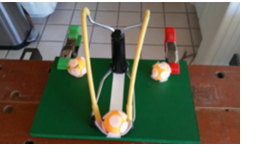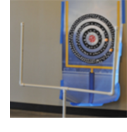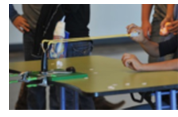Super Bowl Week: STEM and Gridiron Glory
From Rick McMaster
 We are in the midst of our third year of Science Thursday at the Bullock Texas State History Museum in Austin. At these monthly event's, we offer hands-on STEM activities that have connections to Texas history as well as its culture and environment. In September a new exhibit opened, “GRIDIRON GLORY - The Best of the Pro Football Hall of Fame”. After all, Texas is the home of “Friday Night Lights” – both the movie and television show. The challenge was to develop a short activity associated with this exhibit for the students on field trips to the museum. We are in the midst of our third year of Science Thursday at the Bullock Texas State History Museum in Austin. At these monthly event's, we offer hands-on STEM activities that have connections to Texas history as well as its culture and environment. In September a new exhibit opened, “GRIDIRON GLORY - The Best of the Pro Football Hall of Fame”. After all, Texas is the home of “Friday Night Lights” – both the movie and television show. The challenge was to develop a short activity associated with this exhibit for the students on field trips to the museum.
The criteria we had to meet included:
- STEM and exhibit -related
- Easy to implement
- Quick to do (to avoid taking too much time away from the museum exhibits)
and, most importantly,
- Of interest to both 4th and 7th graders (when they study Texas history) and both girls and boys.
 What could be more exciting than completing a pass or making a field goal? We had to scale something to match the Austin room at the museum. What could be more exciting than completing a pass or making a field goal? We had to scale something to match the Austin room at the museum.
We decided to purchase slingshots with hollow handles that would allow each to be solidly mounted to a board via a dowel. My wife painted the mounts gridiron green and added a white stripe, keeping with the overall football theme. Each assembly was solidly clamped to the tables. (The photo is the prototype in my kitchen.)
 We needed receivers and field goal posts. Kaitlin, at the museum, had life size photos of receivers from the archives printed and hung on the wall. The field goal was also a poster with a target superimposed plus a 1/6 scale post made from PVC tubing which allowed easy assembly and disassembly. (Even at 1/6 scale, it was big – but this is Texas!) We needed receivers and field goal posts. Kaitlin, at the museum, had life size photos of receivers from the archives printed and hung on the wall. The field goal was also a poster with a target superimposed plus a 1/6 scale post made from PVC tubing which allowed easy assembly and disassembly. (Even at 1/6 scale, it was big – but this is Texas!)
We still needed footballs. That was easy, orange ping pong balls. We used – VELCRO® dots – loops for the ping pong balls and hooks for the posters so the students could easily verify that they had hit their target. The dots weren’t really needed for the PVC field goal posts but they allowed the students to test their theories on trajectory.
So where was the STEM? The shooter could change the pitch of the shot by varying the angle of the latex tubing and alter the distance the rubber was pulled back. Understanding how each affects the trajectory and accuracy of the throw or kick was very important – both math and science here. Several teachers took the discussion further and talked about how the slingshot compared to the anatomy of the throw made by quarterbacks.
 We learned two important lessons. We learned two important lessons.
- The hand on a receiver was a too challenging target for the younger students. That’s why we included the goal posts as a much larger target.
- Many students like to launch the ping pong balls fast, probably faster in scale than the fastest baseball pitch, and so fast that it would be impossible for receivers to handle. At high speeds, the dots didn’t stick very well. The students needed to be encouraged not to pull the slingshot pocket too far back.
 If you need further details on this activity, feel free to contact me. I will have a detailed description of how to replicate this activity available soon. If you need further details on this activity, feel free to contact me. I will have a detailed description of how to replicate this activity available soon.
I’ll share my experience with the “Impact of STEM” in the near future. Hint: it’s really about a classroom activity on impact craters.
Rick McMaster retired from IBM as the STEM Advocate in December 2013, but continues his work in “STEM and more” through occasional tweets and blogging, continuing to serve on various technical boards, and chairing the Central Texas Discover Engineering outreach. You can reach him at drrhmcm@gmail.com, for continuing discussion.
Back to newsletter |